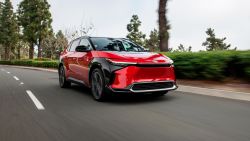President Donald Trump threatened on Tuesday to cut all General Motors subsidies after the automaker announced thousands of jobs cuts.
“Very disappointed with General Motors and their CEO, Mary Barra, for closing plants in Ohio, Michigan and Maryland,” Trump tweeted. “We are now looking at cutting all @GM subsidies, including for electric cars.”
GM (GM) stock declined as much as 3.8% on the comments. GM closed 2.6% lower, wiping out a chunk of Monday’s gains.
Trump’s threat came a day after GM announced plans to cut 14,000 jobs and shut five facilities in North America,dealing a blow to the president’s promise to help auto workers. GM said the moves are designed to prepare the company for a future of driverless and electric vehicles. GM is also responding to a consumer shift away from sedans in favor of trucks and SUVs.
It’s not clear what subsidies Trump was referring to.
A person familiar with the matter told CNN Business that GM is unaware of any significant federal subsidies the company is receiving beyond a $7,500 plug-in tax credit, which goes to the consumer, not the company.
The federal government provides that tax credit for each plug-in vehicle purchased. However, this subsidy goes away once an auto maker reaches 200,000 electric cars sold. And GM may hit that threshold by the end of the year, making its 2019 and 2020 tax credits smaller.
“The entire industry qualifies for this. It’s nothing exclusive to GM,” said Jeremy Acevedo, manager of industry analysis at Edmunds.
Tesla (TSLA), the leading electric car maker, already hit the 200,000 milestone earlier this year. Its tax credit will start getting smaller on January 1.
In a statement, GM said it remains committed to “maintaining a strong manufacturing presence in the U.S.” The company pointed to more than $22 billion of investments in domestic operations since 2009. GM noted that the restructuring announced on Monday is aimed at supporting future growth and long-term success. And GM said that “many” impacted workers will have the opportunity to shift to other GM plants.
“We appreciate the actions this administration has taken on behalf of industry to improve the overall competitiveness of U.S. manufacturing,” GM said.
Between 2009 and 2014, the Energy Department provided loans and grants toward the development of electric vehicles and energy saving technology. Tesla, Nissan and Ford participated, but GM did not, according to the Energy Department.
GM also does business with the federal government, including by selling cars and trucks used by various agencies. Chevy Suburbans are a staple for the Secret Service that protects Trump and other federal officials. GM also manufactured “The Beast,” the souped-up Cadillac that transports the president.
And GM teamed up with the United States Army to develop the hydrogen-powered Chevrolet ZH2 off-road truck. The 6 1/2-foot truck, which has camouflaged Kevlar-reinforced carbon fiber skin, could be used in disaster zones or in conflicts.
Preparing for the future
The GM job cuts hurt Trump’s campaign promise to bring back American auto jobs. But Barra isn’t paying attention to the next election. She’s taking steps to prepare GM for the future of transportation: driverless cars, electric vehicles and ride sharing.
“It’s for the long-term viability of the company,” Acevedo said. “They are doubling down on what they perceive as the future so that they don’t get left behind.”
While GM did not cite tariffs for the plant closure, Trump’s trade crackdown has created problems for the auto industry. GM has said higher commodity prices and currency headwinds will cost the company $1 billion. GM’s major commodity costs are steel and aluminum, both of which have climbed in price in response to Trump’s tariffs.
The battle with Trump puts Barra in a difficult spot. Last year, Barra and other business leaders agreed to serve on a CEO council formed to advise Trump. However, Trump’s advisory panels collapsed in August 2017 following a backlash over the president’s comments on the violence at a white nationalist rally in Charlottesville, Virginia.
Revisting the auto bailout
Of course, the biggest federal subsidy for GM was the auto bailout following the Great Recession. Taxpayer money supported GM through the 2009 bankruptcy and allowed it to emerge from the restructuring.
“The U.S. saved General Motors, and this is the THANKS we get!” Trump tweeted on Tuesday.
While the US government turned a profit on the TARP bank bailout, it lost money on the auto rescue from a strict dollar sense. GM received $49.5 billion from the Treasury Department, but taxpayers lost about $10.6 billion.
Still, allowing the auto industry to go under would have been even more costly in terms of lost tax revenue from individuals, suppliers and the cost of food stamps and unemployment.
CNN Business’ Peter Valdes-Dapena contributed to this report.


























